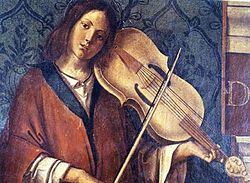Lira da braccio
The lira da braccio was a European string instrument that was played with a bow. It was used during the Renaissance.[1] Italian poet-musicians in court in the 15th and 16th centuries often played it to accompany the poems they were reading. The lira da braccio was very similar to the medieval fiddle. Changes continued to be made to the way the lira da braccio was made until the end of the 16th century. In paintings it is often seen being played by the gods Orpheus and Apollo. Sometimes it was used in groups of instruments.
 "Italianische lyra de bracio" as illustrated by Michael Praetorius | |
| Classification | String instrument |
|---|---|
The instrument was a similar shape to a violin, but with a wider fingerboard and flatter bridge. It usually had seven strings, five of them tuned like a violin with a low D added to the bottom, and two other strings for drones. It is likely that the player often played the tune on the top strings and chords on the lower strings.
The lira da braccio was very popular at court. Later, in the 16th century, the madrigal became very popular and also the violin, so the lira da braccio was used less. It continued to be used in plays, especially when it was associated with Apollo. By the middle of the 17th century people no longer played it.
Lira Da Braccio Media
Lira da braccio player by Bartolomeo Montagna, c. 1500
Lira da braccio by Giovanni d'Andrea, (1511). Kunsthistorisches Museum Vienna
References
- ↑ Arkenberg, Rebecca (October 2002). "Renaissance Violins". Retrieved 2006-09-22.
Other websites
![]() Media related to Lira da braccio at Wikimedia Commons
Media related to Lira da braccio at Wikimedia Commons
